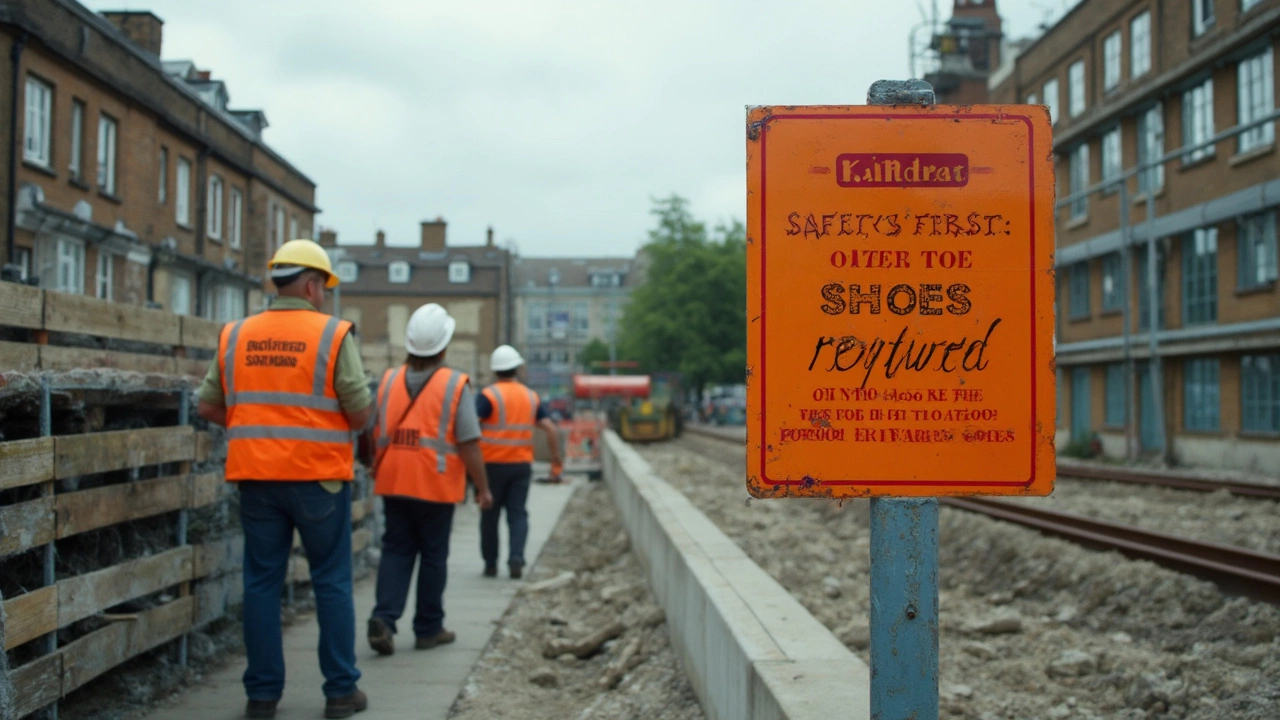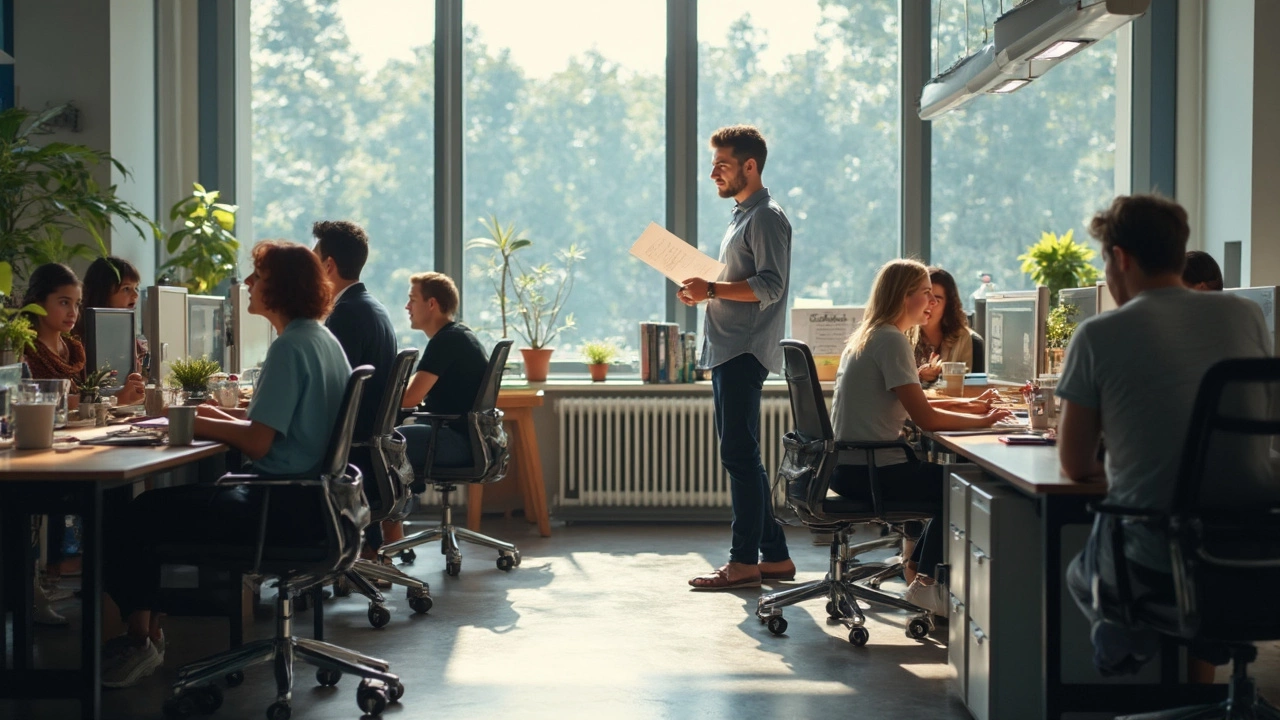Showing up to work in sandals might seem like an easy way to beat the heat, but is it actually allowed? Under OSHA—the big safety boss for American workplaces—your shoes can turn into a problem faster than you think. Believe it or not, OSHA doesn't spell out “no open-toed shoes” in their main rules. It all comes down to what kind of hazards you might run into while you’re clocked in.
If there’s anything on the floor that could drop, roll, squish, or even splash onto your feet (think hot coffee, chemicals, or heavy boxes), you’re already in OSHA’s danger zone. In those cases, even something as simple as wearing flip-flops could land your workplace with a violation. Most jobs that deal with machinery, kitchens, warehouses, or construction automatically call for tougher footwear—open-toed shoes just don’t cut it.
- What OSHA Really Says About Open-Toed Shoes
- When Open-Toed Shoes Become a Problem
- Industries and Jobs Where Closed-Toe Shoes are a Must
- Practical Tips for Picking Safe (and Acceptable) Work Shoes
What OSHA Really Says About Open-Toed Shoes
Let’s clear up something—nowhere in OSHA’s main rules do they yell, “No open-toed shoes!” Instead, OSHA focuses on job hazards, not shoe styles. What matters is if your work environment puts your feet at risk. In OSHA’s own words:
“The employer shall ensure that each affected employee uses protective footwear when working in areas where there is a danger of foot injuries due to falling or rolling objects, or objects piercing the sole, and where such employee’s feet are exposed to electrical hazards.” — OSHA Standard 1910.136(a)
That’s a mouthful, but here’s the takeaway: it’s all about the job, not the sandals. If there are falling objects, sharp stuff, squishing hazards, or electrical risks around, those cute open-toed shoes won’t cut it. OSHA expects employers to check for these dangers and make sure workers wear the right work shoes for the situation.
If your work is mostly desk-based and doesn’t involve things dropping, rolling, or splashing onto your toes, OSHA probably isn’t worried about your open-toed shoes. But the moment things get risky (think warehouses, kitchens, factories), your bosses have to step in with safer work shoes.
To put it plainly: OSHA cares about foot protection, not fashion. They leave it up to the workplace to figure out what shoes make sense, based on what could actually hurt your feet. Some employers go above and beyond and ban open-toed shoes everywhere, just to avoid any gray areas or arguments with inspectors.
Here’s a quick breakdown of what triggers OSHA to care about your shoes:
- Moving or falling heavy items
- Sharp objects on the floor
- Chemicals that could spill
- Hot liquids or food
- Electrical exposure risks
If any of those show up on your job site, it’s time to ditch the sandals and grab your closed-toe work shoes. As a side note, in a 2023 OSHA inspection sweep, about 11% of cited violations in manufacturing jobs came from not having proper protective footwear on the floor. That’s a chunk nobody wants to pay fines for.
When Open-Toed Shoes Become a Problem
You might love the fresh air on your toes, but open-toed shoes raise real safety concerns at work. Think about a busy restaurant kitchen—one clumsy move and boiling water’s on your foot. Or a warehouse where things are always dropping off shelves. In these environments, open-toed shoes are not just risky—they’re usually breaking company rules, and OSHA can step in if someone gets hurt.
OSHA’s standard 29 CFR 1910.136 doesn’t come right out and ban sandals, but it clearly says workers need “protective footwear” if there are hazards. The rule covers risks like falling or rolling objects, sharp items, or even electrical hazards. If you can stub, stab, smash, or burn a toe at your job, that’s exactly the situation OSHA is worried about.
“Employers must ensure that each affected employee uses protective footwear when working in areas where there is a danger of foot injuries ...”
– U.S. Occupational Safety and Health Administration (OSHA 29 CFR 1910.136)
Here are some quick scenarios where wearing open-toed shoes can easily become an OSHA issue:
- Restaurants & Kitchens: Hot oil or knives can slip off the counter—and your toes aren’t protected.
- Construction sites: Heavy tools, nails, or concrete mix don’t mix with bare feet or sandals.
- Warehouses: Dropped merchandise or pallet jacks can crush exposed toes in a second.
- Labs or Hospitals: Chemicals, blood, and sharp instruments turn open shoes into a hazard.
Here’s a quick look at which jobs and accidents make open-toed shoes a legal landmine:
| Job Type | Typical Shoe Rule | Common Foot Risks |
|---|---|---|
| Retail Cashier | Usually allowed | Minimal risks |
| Restaurant Kitchen Staff | Closed-toe required | Spills, burns, sharp objects |
| Construction Worker | Steel-toe required | Heavy or sharp items |
| Office Worker | Open-toed sometimes allowed | Few hazards |
If your job puts your feet in the “danger zone,” your boss is supposed to enforce the right footwear. If they let you get away with open-toed shoes and you get hurt, it can cost both you and the company. Workers’ comp may deny claims, and OSHA fines can reach thousands of dollars for not protecting workers’ feet. So, when in doubt, cover up those toes at work.

Industries and Jobs Where Closed-Toe Shoes are a Must
Some workplaces don’t mess around when it comes to workplace safety. For these jobs, closed-toe shoes are non-negotiable, no matter how much you love your sandals. The main goal is to protect your toes from real threats like falling tools, heavy carts, sharp objects, or even nasty chemical spills.
The obvious places? Construction sites lead the pack. OSHA actually mandates protective footwear anytime there’s a risk of foot injuries—picture hard hats on your feet. Warehouses, factories, and machine shops require closed-toe shoes too, mostly steel-toe boots or at least sturdy work shoes. Manufacturing jobs, especially around metal or glass, won’t let you near the floor in open-toed shoes. Kitchens in restaurants, bakeries, and food processing plants also ban sandals, since burns, oils, and sharp utensils are all over the place (kitchen floors are basically obstacle courses for feet).
Healthcare is another big one. Most hospitals demand closed shoes for nurses, doctors, lab techs, and janitors. There’s just too much risk—think needles, body fluids, or dropped equipment. Janitorial work in any building usually comes with the same rule for the same reasons.
Just so it’s super clear, here’s a list of jobs where open-toed shoes really aren’t an option:
- Construction workers and building trades (plumbers, electricians, etc.)
- Warehouse and factory workers
- Restaurant cooks, kitchen staff, and food processors
- Nurses, doctors, lab and pharmacy staff
- Janitors and cleaning crews
- Mechanics and auto shop employees
- Landscapers using heavy tools or mowers
Here’s a quick look at some real numbers. According to OSHA, foot injuries send more than 60,000 workers to the ER every year. Most of those accidents are from falling objects or cuts that proper shoes could have stopped. In industries like construction and manufacturing, injuries dropped 50% after rules about the right work shoes were enforced.
| Industry | Injury Rate per 10,000 Workers* | Footwear Policy |
|---|---|---|
| Construction | 14.7 | Mandatory closed-toe, steel-toe for hazards |
| Manufacturing | 8.3 | Mandatory closed-toe, slip-resistant often required |
| Healthcare | 7.1 | Closed-toe shoes required on all clinical floors |
| Food Service | 10.5 | Non-slip, closed-toe only |
*Source: U.S. Bureau of Labor Statistics, 2023
If you’re ever not sure what you need on your feet, don’t just guess—ask your safety manager or supervisor. Sometimes company rules are even stricter than OSHA guidelines, especially if insurance or injury rates are on the line. If you show up to the wrong job in open-toed shoes, odds are you’ll get sent home to change. Worse, repeated slip-ups could mean bigger problems for you or your workplace.
Practical Tips for Picking Safe (and Acceptable) Work Shoes
Choosing the right shoes for work can be confusing. You want comfort, but if you ignore safety, you might not just hurt your toes—you could end up breaking workplace rules and risking a fine for your employer. Sticking to OSHA basics doesn't have to be hard, though. You just have to know what to look for.
- Check your workplace hazards. Do you walk around wet floors, carry stuff, or move through a warehouse? If yes, open-toed shoes are probably a no-go. It’s not just about sharp objects—spilled coffee or dropped tools count, too.
- Read your company’s dress code. Some companies follow OSHA guidance to the letter; others are even stricter. If the handbook bans open-toed shoes, no amount of debating will save your flip-flops.
- Pick shoes with closed toes and covered heels if you notice frequent spills, chances of impact, or heavy things moving around. Steel-toe boots or sturdy sneakers are the usual winners in these spots.
- Prioritize non-slip soles if your job includes spills or slick floors. Restaurants, hospitals, and even offices with polished floors will often require this for safety—and insurance reasons. The CDC says falls are one of the top reasons people get injured at work in the U.S., so those grippy soles are worth it.
- For less risky office jobs, you’ve got more flexibility. Still, avoid anything flimsy that won’t protect you if you stub your toe or trip over a box under your desk.
If you’re not sure, talk to HR or your safety manager. Some workplaces actually provide a list of approved work shoes and even offer discounts or reimbursements.
| Type of Job | Shoe Recommendation |
|---|---|
| Construction/Warehouse | Steel-toe boots, closed heels, non-slip |
| Kitchen/Restaurant | Closed-toe, non-slip, water-resistant |
| Healthcare | Closed-toe, cushioned, easy to clean |
| Office | Closed-toe, business casual, basic non-slip |
Don't be shy about comfort, though. Hours on your feet are tough, so look for shoes with reliable cushioning and arch support. Liam once tried to save money on cheap work shoes and regretted it for months—nobody wants sore feet before lunchtime. With the right combination of OSHA-approved features and comfort, you’ll get through your shift safer and probably happier, too.
